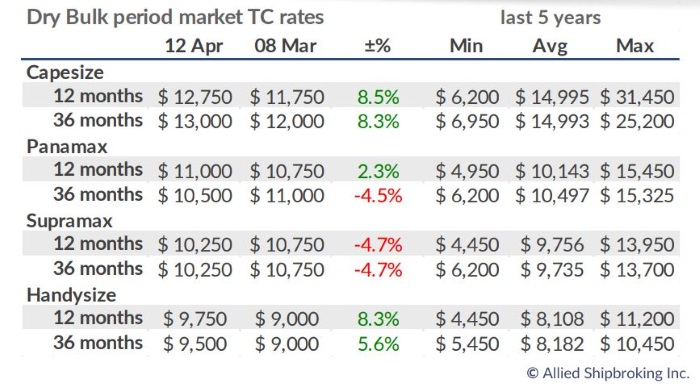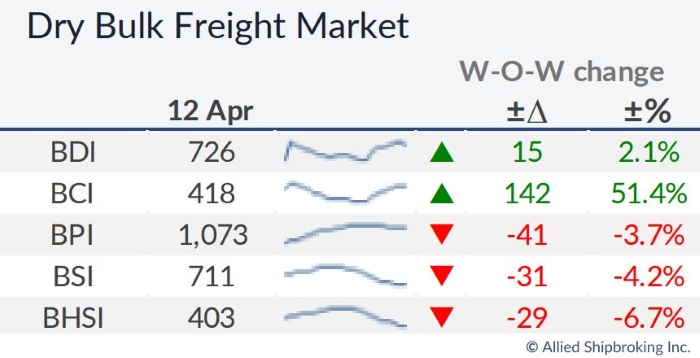Dry Bulk Market: Could Coal Become the “Savior” of the Dry Bulk Market?

By Nikos Roussanoglou
April 19, 2019 - The disruption in the iron ore seaborne trade this year has been well documented, together with the negative impact that this development has had in the Capesize dry bulk segment. However, analysts point out that coal trade could prove to be a dampening factor in the market, helping to alleviate part of the demise of the first few months of 2019. In its latest weekly report, shipbroker Allied said that “the collapse noted in the iron ore trade volumes has steered several ship-owners to seek alternative sources of earnings. With coal estimated to account more than 50% of the total ton-mile demand in the Panamax and more than 15% in the Capesize segment (similar levels noted for the Supramax and Handysize), it is foreseeable that this “black diamond” trade will attract the interest of many. The most tradeable type of coal is steam (thermal) coal, currently used to produce around 38% of the total electricity generation in the world”.

According to Mr. Yiannis Vamvakas Research Analyst with Allied, “despite the “green” policies and goals for emission cuts from several countries, total worldwide exports in 2018 increased by around 3.6%. In India, one of the most important net importers of coal, steam coal imports rose in 2018 by the fastest pace noted over the last four years. With approximately 75% of domestic electricity generation being still produced from coal, this is of little surprise. In addition, local administration goals to support local production and limit imports for the state-owned companies have not been met. More specifically, the government goal for production to reach 1 billion metric tons by 2020 by the CIL (state owned coal mining company), which would be used by state owned electricity producers instead of imported coal, was significantly derailed, with the goal now set for 2026”.
Vamvakas added that “meanwhile, prospects for coal imports amongst Asian countries are showing promise, as it is estimated that around 40 GW of coal-fired generation is currently under construction and projected to come online during the next 5 years. In China, imports of coal have increased significantly since 2016, as the Chinese government decision to address environmental issues has also resulted in the shutting down of obsolete coal mining sites. As a result, imports grew by 9% in 2018, to fire up the 65% of the total domestic electricity production that is currently generated through coal powered generators. Expectations aren’t for the same level of growth to be noted this year, given that government restrictions likely to keep levels on par with was seen in 2018. With regards to the long term, the planned expansion in coal fired production stands at figures above 200 GW, indicating that coal demand from the Asian giant will rise significantly over the following years”.
“Meanwhile, demand in other Asian countries, such as Vietnam, South Korea and the Philippines have also shown strong growth during the past couple of years, with extra coal-fired power generation being capacity added each year, due to the lower cost involved compared to other competing fuels. Despite all this, there are some importers that have seen a decline in imports during 2018, with the same trend being anticipated for 2019 as well. In the EU, climate related policies have trimmed the use of steam coal significantly. Estimates show that another drop of around 5% in steam coal imports is set to take place in 2019, on top of the 7% drop witnessed in 2018. In Japan, thermal coal imports declined by 0.6% in 2018 due to slower economic growth and an increase in the use of greener fuel sources”, Allied’s analyst said.

He noted that “the growth of thermal demand in India and SE Asia helped boost trade volumes in 2018, while prospects for 2019 are remain positive thanks to the additional coal-fired capacity that is planned to come online. All in all, the trade in the Pacific basin is expected to remain firm, marginally countering the decline that is forecasted for the Atlantic basin, leading to a net minor increase in the total global trade of steam coal. This may well be minor, but it may well prove crucial to provide the much needed support being sought after right now in the dry bulk freight market”, Vamvakas concluded.

